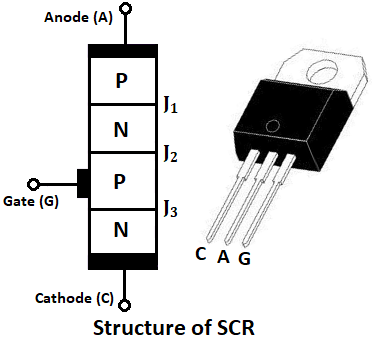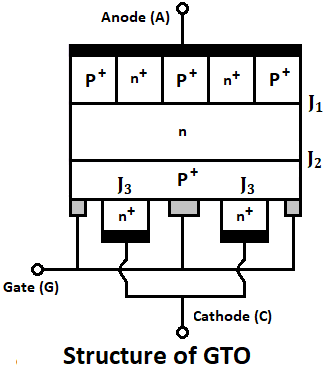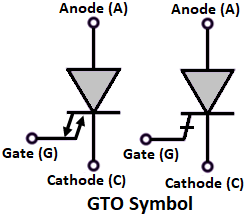SCR (Silicon Controlled Rectifier) :
SCR is basically a silicon-made controlled device or semiconductor device extensively used in power electronic circuits. It is a type of thyristor with four layers of p-type and n-type silicon placed alternatively. SCR has three terminals, anode, cathode, and gate with three PN junctions as shown below.
When the anode is connected to the positive terminal and the cathode to the negative terminal with the gate terminal open, the junctions J1 and J3 are forward biased while J2 is reverse biased. In this condition, there will be no conduction of current through SCR except a small leakage current and thus SCR will be in OFF-state.
In order to turn ON the SCR, there are two methods either by increasing the forward voltage to a sufficiently larger value such that reversed biased junction J2 will break down (which could be destructive and is not recommended) or by applying a positive voltage signal between gate and cathode.
GTO (Gate Turn-OFF Thyristor) :
Above we have seen that, in order to turn ON an SCR (to bring SCR from OFF-state to ON-state), a positive voltage signal is applied at the gate terminal. However, once the SCR is turned ON, the gate terminal losses its control over the SCR and it cannot be turned OFF with the help of the gate terminal.
The SCR can be again brought into the OFF state only by reducing the forward current to less than the value of the holding current. In order to achieve this, there is a requirement for an external circuit (commutation circuit) that reduces the forward current of SCR. GTO is another type of thyristor similar to SCR for which the gate has full control (both turning OFF and turning ON) over the operation.
Similar to SCR, a positive signal is given to the gate of GTO in order to turn ON. But it is an additional feature that it can be brought back to OFF-state by applying a negative pulse at the same gate terminal, thereby eliminating the requirement of the commutation circuit.
Difference Between GTO and SCR :
Key Differences Between GTO and SCR :
- Compared to the structure of SCR, the GTO has an additional n+ layer at the anode which forms the turn-OFF circuit between gate and cathode.
- The size and weight of the GTO circuit are less compared to the SCR circuit.
- Due to the requirement of external circuits to turn OFF the SCR, the cost of the overall unit increases. Also, the cost of a commutation circuit increases with increases in switching frequency. But there is no such limitation of switching frequency in the case of GTO due to the absence of the commutation circuit.
- The V-I characteristics of GTO are similar to SCR. But for GTO the values of holding current and latching current are higher as compared to conventional SCR of the same rating.
- Due to the absence of the commutation circuit which in turn eliminates the commutation losses, the efficiency of GTO is high compared to SCR.
- Due to multi cathode structure of GTO, the gate triggering current required for GTO is more than the gate triggering current required for conventional SCR devices.
- The switching speed of GTO is faster than conventional SCR permitting high switching frequencies with high withstand capability of voltage and current values.
- The ON-state voltage drop of GTO is more than SCR, thus there is a considerable power loss.
- Due to the elimination of the commutation circuit for GTO, the acoustic and electromagnetic noise from commutating components in force commutation is reduced.




